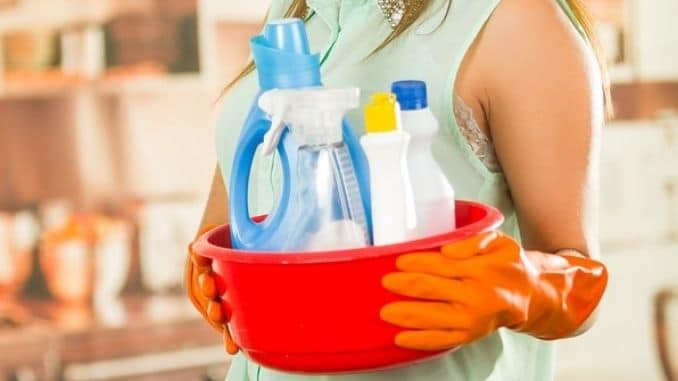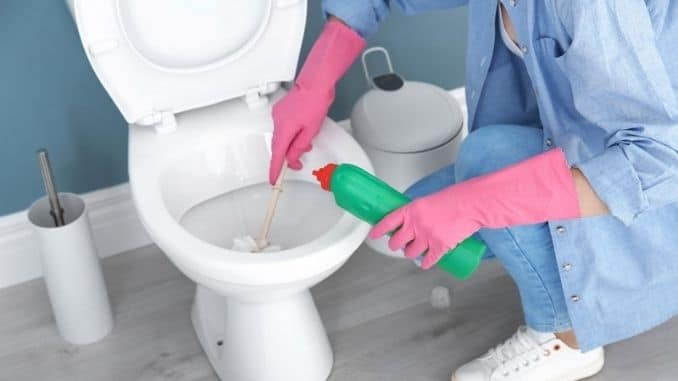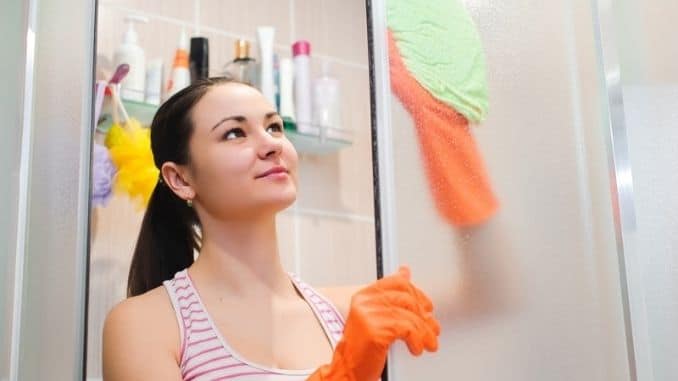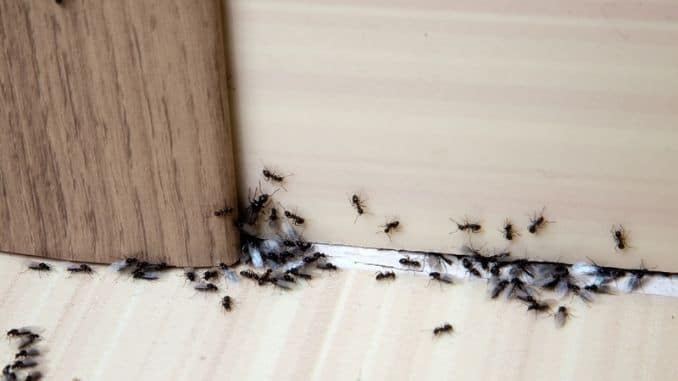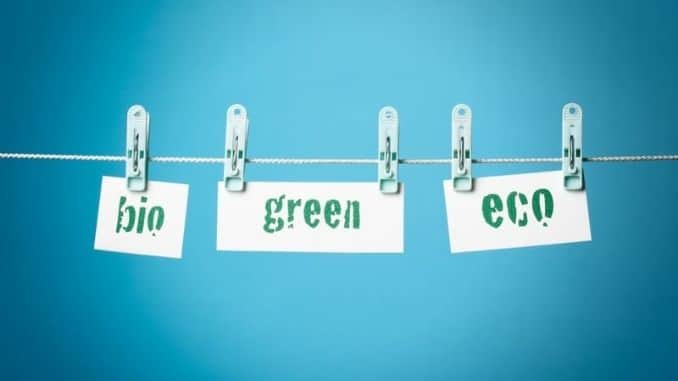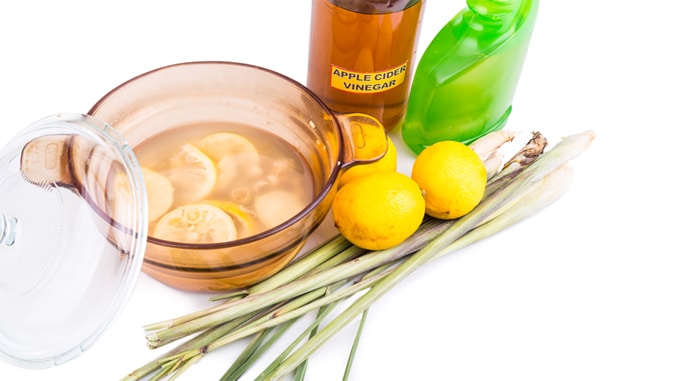
We all want to protect ourselves and our families from toxic chemicals and deadly poisons. For the most part, avoiding toxins seems pretty simple. However, what about the items within each of our homes that contain hazardous or even deadly ingredients?
Reducing your exposure to toxins inside of your own home is a worthwhile endeavor. To help, we’ve made a list of some of the more common toxic products often found in and around the house. For each toxic substance, we’ve got a natural, non-toxic alternative.
1. Multisurface Cleaners
One of the most common toxins in the home is multisurface cleaner. It is used to clean and disinfect countertops, sinks, tabletops and most solid surface areas in homes.
Why it’s toxic: Most multisurface cleaners contain 2-butoxyethanol. 2-butoxyethanol is a hazardous ingredient that is not required, by law, to be listed on a product’s ingredient list. However, according to the United States Environmental Protection Agency (EPA), 2-butoxyethanol can cause liver and kidney damage as well as respiratory problems and narcosis.
Natural alternatives: Look for a plant-based multisurface cleaner with a clear and complete ingredient list on the label. The ingredient list should contain substances that are nontoxic. Avoid products that list “fragrances” on the label.
Another natural alternative for a multisurface cleaner is a half-and-half solution of white vinegar and water with antimicrobial essential oils added.
2. Toilet Bowl Cleaner
We all want sparkling clean toilets. Even the greenest of homes will sometimes have a hidden stash of caustic toilet bowl cleaner in the bathroom cabinet.
Why it’s toxic: Toilet bowl cleaners generally contain hydrochloric acid. Hydrochloric acid is highly irritating to the eyes and skin. Breathing fumes of hydrochloric acid can cause kidney damage and respiratory tract irritation.
Natural alternatives: Because of demand, several environmentally friendly companies have created nontoxic toilet bowl cleaners that work to dissolve that disgusting ring of sediment that forms around the water level inside the toilet bowl. Look for a product with a chemical-free ingredient list.
If you prefer to make your own toilet bowl cleaner, spray the inside and outside of the toilet with a mixture of white vinegar and several drops of tea tree oil. Allow it to sit for about 10 minutes. Then, sprinkle 1/2 cup to 1 cup of baking soda inside the toilet bowl and scrub it with a toilet brush until all sediment is removed. Use a damp towel to wipe off the cleaner from the outside of the toilet.
3. Oven Cleaner
Ovens get very dirty over time. Baked on food items can be quite difficult to remove with elbow grease alone. Modern oven cleaner spray has made the once challenging task of cleaning the oven so very easy.
Why it’s toxic: Oven cleaners can contain all sorts of toxins. Three of them that we found particularly disturbing are lye, methylene chloride, and sodium hydroxide. Lye is extremely toxic. It can dissolve human skin and blind a person if it comes in contact with the eyes. Methylene chloride is highly carcinogenic, and sodium hydroxide can cause burning and serious respiratory problems when it’s inhaled.
Natural alternatives: There are very few oven cleaners on the market that are safe to use in your home. However, one that we found is made by the same company that makes baking soda. It is approved as safe by the Environmental Working Group (EWG). It’s made mostly of baking soda.
That’s right ― baking soda works wonders on your dirty oven. It just takes a little time. Here’s our advice: Make a paste of baking soda and water. The paste should be about as thick as toothpaste. Use a pastry brush or a paintbrush and paint the paste all over the inside of your oven ― especially the really baked-on grimy parts. Do not put it on the heating elements. Do not turn on the oven. Just close it and walk away. Do something else for at least eight hours. Then, come back, spray the now-dried baking soda paste with water, and use a wet sponge to wipe it off. You won’t have to do any serious scrubbing. The baked-on food items will come right off magically with the baking soda paste. Because this method takes eight hours, it’s nice to apply the paste before bed and wash it off sometime in the morning.
4. Daily Shower Cleaner
The shower is supposed to be clean. It’s a clean place. No one wants to wash up in a dirty shower with cloudy glass doors. Daily shower cleaner to the rescue. Take your shower and then, while you’re still in the shower, take 20 seconds to spray the glass doors, shower walls, and fixtures with a daily shower cleaner. That’s it. Your shower stays good and clean without the need for scrubbing.
Why it’s toxic: Daily shower cleaner is especially troubling. This is a product that you spray onto the shower walls while you stand inside the shower. You are literally inside the shower stall, spraying a product all around you and breathing it in. According to the EWG, many of the leading daily shower cleaners contain lauryl pyrrolidone, phthalates, and bleach. Lauryl pyrrolidone can cause irritation and damage to the skin. Phthalates have been shown to affect the reproductive system negatively, cause problems within the body’s central nervous system and induce respiratory distress. Bleach can cause respiratory issues as well. It can also affect the endocrine system and cause skin irritation.
Natural alternatives: Becky Rapinchuk, author of “Clean Mama’s Guide to a Healthy Home,” uses a mixture of 1/2 cup vodka, 1 cup water and 10 drops of peppermint oil in a spray bottle. It works quite well as a daily shower cleaner. Rapinchuk recommends storing this cleaner inside the shower stall and using it just as you would any store-bought daily shower cleaner. No rinsing required.
You can also purchase plant-based, non-toxic daily shower cleaners online and in some stores.
5. Drain Opener
It isn’t if your sink will get clogged, it’s when. Clearing drains is just a part of living in a home. Hair, toothpaste, soap residue, and oils will cause a sink to stop draining properly eventually. When that happens, you can invest a couple of hours taking apart and cleaning the drainage pipes, or you can pour some good old drain opener into the pipes and get things moving again.
Why it’s toxic: The EWG has found that most drain openers contain the chemical sodium hypochlorite. Sodium hypochlorite can cause damage to human organs when inhaled. It can also damage the reproductive and nervous systems and cause developmental problems and possibly cancer.
Natural alternatives: While you can find some fairly natural drain cleaners at the home improvement store, these products may still contain caustic ingredients. If you’re buying a greener drain opener, read the labels carefully.
Bob Vila, home improvement television show host and author of “This Old House,” posted a recipe for an all-natural, homemade drain cleaner on his website. Vila suggests using a small bucket to remove any standing water in the sink first. Then, combine 1/2 cup baking soda, 1/2 cup salt, and 2 tablespoons cream of tartar in a Mason jar. Shake it up until it’s mixed completely. Pour half of the mixture down the drain. Save the rest for future clogs. Then, use a kettle to boil around 2 cups of water. Pour the boiling water down the drain and let it all sit for at least one hour. After the hour is up, run water in the sink to clear the pipes and make sure everything drains.
6. Bug Killer
It’s natural to want a home free from bugs and pests. Hiring a pest control company or buying and spraying insecticides is an easy fix.
Why it’s toxic: Bug poisons, including ant killer and cockroach spray that are often used around the house, normally contain a class of insecticides called pyrethroids. According to Planet Cognition, a group that tracks and reports information about chemical sensitivities, “Pyrethroids cause harm to the brain and nervous system. They can lead to lower test scores and scholastic performance. Children exposed to pyrethroids also tend to have behavior problems.”
Natural alternatives: You can buy borax-based ant and roach killer. Borax isn’t toxic to humans, but it is toxic to bugs. When the bugs eat it and take it back to their nests, they infect their entire group. Within a few hours, they all die.
If you happen to have some borax on hand around the house, you can mix it with something sweet like grape jelly or corn syrup in equal parts. Then, place a few spoonfuls of the mixture inside of a jar lid or another very shallow container. You can even smear some of the mixtures onto an index card. Then, place it in an area where ants or other bugs like to congregate, such as behind the trash can or near the oven. Leave it overnight. The ants will be all over it, and then they’ll be gone. This application works quickly.
For spiders, scorpions and other bugs, use peppermint and cedarwood essential oils in your multisurface cleaners and your mop water. When I make my countertop cleaner, I add 10 to 20 drops of cedarwood and peppermint oil to the solution. Cedarwood repels all types of insects and pests. Peppermint is especially good at repelling spiders. Use more oils when the seasons change as bugs are more likely to try to invade during that time.
A note on greenwashing. Manufacturers of household cleaners, pesticides, and other toxic solvents have taken note of the demand for safer, greener products. Some of them have worked to produce better, less-toxic solutions for their customers. Sadly, many other companies have simply altered their labels with words like “all-natural” and “gentle on your skin” to make their very toxic products seem greener and less harmful. This shady practice is called greenwashing.
Don’t be greenwashed. Read the labels. Don’t buy household products that don’t have ingredient lists printed clearly on their labels. You should always know what kind of cleaning solutions, lawn products, and solvents you’re bringing into your home. Green labels aren’t enough.
Replace your household toxins with natural alternatives. For your health and safety and that of your family and visitors, take some time this weekend to ditch all of the toxic, chemical, household products you have and replace them with natural alternatives.
Just like our cleaning products, what we put in our bodies is essential for our health and wellbeing. Check out The Best Foods that Rapidly Slim & Heal in 7 Days, here!

